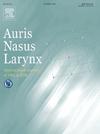耳膜破裂的影像学表现及半规管破裂Yenigun分型的发展
IF 1.5
4区 医学
Q2 OTORHINOLARYNGOLOGY
引用次数: 0
摘要
目的上半规管破裂是耳膜破裂中最常见的一种。然而,其他几种开裂影响半规管、耳蜗和前庭。我们的研究旨在探讨第三窗综合征患者放射学囊破裂的频率、分布和相关性。此外,我们还提出了一种新的半规管破裂分类系统。方法本回顾性研究纳入2015年1月至2023年9月在我校附属医院耳鼻喉科就诊,因提示第三窗综合征的症状,行标准整形及Poschl平面CT扫描的病例。头颈放射科医生和普通放射科医生共同评估每台CT并决定测量值。结果219例(438例)颞骨有第三窗综合征的提示症状。半圆管开裂分为0型(无开裂)、1型(单侧单管开裂)、2型(双侧单管开裂)、3型(单侧多局部开裂)和4型(双侧多局部开裂)5种类型。219例患者中有71例(32.4%)出现半规管破裂。0:148型(67.6%)、1:31型(14.2%)、2:21型(9.6%)、3:15型(6.8%)、4:4型(1.8%)。耳蜗-面裂和前庭导水管-颈静脉球裂分别见于63/219(28.8%)和21/219(9.6%)。当检查半规管裂孔时,2型和4型明显多于其他类型的耳蜗-面部裂孔。结论双侧半规管破裂患者耳蜗面裂的可能性增加。放射科医生应该对耳膜进行整体评估。应特别注意多通道、双侧定位、耳蜗和前庭裂。本文章由计算机程序翻译,如有差异,请以英文原文为准。
Radiologic prevalence of otic capsule dehiscence and development of the Yenigun classification for semicircular canal dehiscence
Objective
The superior semicircular canal dehiscence is the most well-known otic capsule dehiscence. However, several other dehiscences affect the semicircular canals, cochlea, and vestibule. Our research aimed to examine the frequency, distribution, and correlation between radiologic otic capsule dehiscence in patients exhibiting symptoms of third window syndrome. Additionally, we proposed a new classification system for semicircular canal dehiscence.
Methods
In this retrospective study, we included cases who applied to the Otolaryngology Department of our university hospital between January 2015 and September 2023 and underwent standard reformations and Poschl plane CT scans due to symptoms suggestive of third window syndrome. A head and neck radiologist and a general radiologist jointly assessed each CT and decided on measurements.
Results
The study examined 219 patients (438 temporal bones) with suggestive symptoms of third window syndrome. Semicircular Canal Dehiscences were categorized into five types: Type 0 (No dehiscence), Type 1 (Unilateral single canal dehiscence), Type 2 (Bilateral single canal dehiscence), and Type 3 (Unilateral multiple localization dehiscence), and Type 4 (Bilateral multiple localization dehiscence). Semicircular Canal Dehiscence was observed in 71/219 (32,4 %) patients. Type 0:148 (67,6 %), Type1:31(14,2 %), Type2:21(9.6 %), Type 3:15(6.8 %) and Type 4: 4(1.8 %) patients were detected. Cochlear-Facial Dehiscence and Vestibular Aqueduct-Jugular Bulb Dehiscence were seen in 63/219(28,8 %) and 21/219(9,6 %) patients. When cases with Semicircular Canal Dehiscences were examined, Type 2 and Type 4 were seen significantly more frequently than other types in cases with Cochlear-Facial Dehiscence.
Conclusion
When we examine the otic capsule, we see that the possibility of Cochlear-Facial Dehiscence increases in bilateral Semicircular Canal Dehiscence cases. The radiologist should evaluate the otic capsule as a whole. Particular attention should be paid to multiple channels, bilateral localization, cochlear and vestibular dehiscences.
求助全文
通过发布文献求助,成功后即可免费获取论文全文。
去求助
来源期刊

Auris Nasus Larynx
医学-耳鼻喉科学
CiteScore
3.40
自引率
5.90%
发文量
169
审稿时长
30 days
期刊介绍:
The international journal Auris Nasus Larynx provides the opportunity for rapid, carefully reviewed publications concerning the fundamental and clinical aspects of otorhinolaryngology and related fields. This includes otology, neurotology, bronchoesophagology, laryngology, rhinology, allergology, head and neck medicine and oncologic surgery, maxillofacial and plastic surgery, audiology, speech science.
Original papers, short communications and original case reports can be submitted. Reviews on recent developments are invited regularly and Letters to the Editor commenting on papers or any aspect of Auris Nasus Larynx are welcomed.
Founded in 1973 and previously published by the Society for Promotion of International Otorhinolaryngology, the journal is now the official English-language journal of the Oto-Rhino-Laryngological Society of Japan, Inc. The aim of its new international Editorial Board is to make Auris Nasus Larynx an international forum for high quality research and clinical sciences.
 求助内容:
求助内容: 应助结果提醒方式:
应助结果提醒方式:


